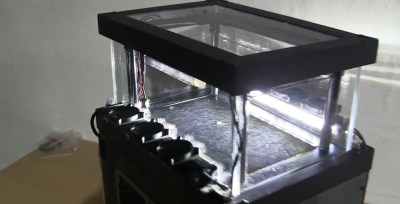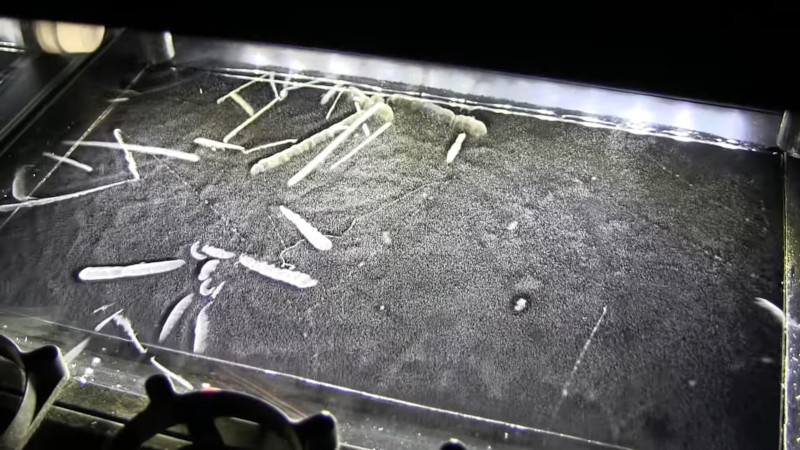Cloud chambers are an exciting and highly visual science experiment. They’re fascinating to watch as you can see the passage of subatomic particles from radioactive decay with your very own eyes. Many elect to build small chambers based on thermoelectric Peltier elements, but [Cloudylabs] decided to do something on a grander scale.

[Cloudylabs] started building cloud chambers after first seeing one in a museum back in 2010. The first prototype was an air-cooled Peltier device, with a cooled area of just 4x4cm. Over the years, and after building many more Peltier-based chambers, it became apparent that the thermoelectric modules were somewhat less than robust, often failing after many thermal cycles. Wanting to take things up a notch, [Cloudylabs] elected to build a much larger unit based on phase-change technology, akin to the way a refrigerator works.
The final product is astounding, consisting of a 32x18cm actively cooled area mounted within a large glass viewing case. A magnet is mounted underneath which causes certain particles to curve in relation to the field, as well as an electrically charged grid up top. The chamber is capable of operating for up to 12 hours without requiring any user intervention.
Cloud chambers are always beautiful, and even moreso at this larger scale. When radioactive materials are introduced into the chamber the trails generated are long and easily visible. It’s a daunting build however, and the final product weighs over 30 kilograms. You might want to start with something a little smaller for your first build. Video after the break.
















Very nice build. Those traces labelled as protons though, aren’t they alpha particles?
They are more or less of the same thickness as when he introduces the 220Rn, whose decay chain is 220Rn -α-> 216Po -α-> 212Pb -β-> 212Bi < … Po & Ti with more betas and alphas
That is terrifying, I know enough that rationally I don’t need to be terrified, but the irrational part of my brain is telling me to hide in a bunker lined with 10 feet of lead for the rest of my life.
Keep in mind that recently made lead won’t save you, as it is contaminated with radioactive lead isotopes that were produced during nuclear weapons tests in the 20th century. Go for medieval sources.
When highly energetic particles hit a shield like lead, they break up into many less energetic particles that are actually more harmful to flesh. So, you need a LOT of lead, and yes it contains its own low-level radioactives. You could dive prospect for pre-atomic ship ballasts.
If there is not a convenient cave or bomb shelter (which of course contain their own low-level radioactives) you could put on SCUBA equipment and get in a pool or other body of water. My pool has borax and other minerals, so it will have its own low-level radioactives as well.
Does someone know a good resource that explains why everything looks very slow going through the chamber?
The ionisation in the track is effectively instantaneous, but the condensation nucleates at one end and propagates at a speed visible to the eye.
Though why it should start at an end and not in the middle, I don’t know.
The comment above started with an indication that it was a wild guess, but the forum chose to remove that, and left it looking like I was making an authoritative statement. I wasn’t.
Maybe because of the Bragg curve.
One end of the track should have more energy deposited to it than the rest, the ‘end’ for protons and the ‘start’ for photons for example (different peak location)
now make one showing dark matter.
Does anyone remember the American Basic Science Club? They used to advertise in comic books and magazines like Boy’s Life. I bought those kits when I was in elementary school and they really set me off into a life of wonder and discovery. One of the kits was a cloud chamber; it was a plastic box that you put dry ice under, and the atomic source was a drop of radium paint on the head of a pin. These kits were pretty much my only foray into electronics with tubes (they did a lot with the 35W4), and a lot of experiments used very high voltages. I remember building a 3-tube regenerative receiver; the way the creator of this kit reused the parts he included in the kits was genius. I never got hurt by anything in these kits, but I sure can’t imagine anything like this flying in today’s litigious society. But man am I ever grateful it was available to me as a kid.
http://onetuberadio.com/wp-content/uploads/2018/10/1958NovBL.jpg
http://vidxer.blogspot.com/2015/12/absc-regenerative-receiver.html
Cool!